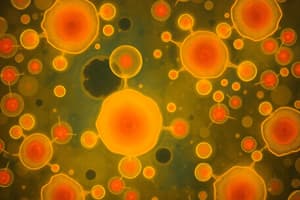Podcast
Questions and Answers
What is the primary function of microfilaments in a cell?
What is the primary function of microfilaments in a cell?
- To assist with cell movement and organelle placement (correct)
- To provide structural support to the cell
- To synthesize proteins
- To form the skeleton of the cell
What is the main component of cytoplasm?
What is the main component of cytoplasm?
- Water (correct)
- Protein
- Nucleic acid
- Minerals
What is the function of microtubules during cell division?
What is the function of microtubules during cell division?
- To synthesize DNA
- To move chromosomes (correct)
- To regulate cell growth
- To provide structural support to the cell
What is the cytoskeleton composed of?
What is the cytoskeleton composed of?
What is the primary function of the cytoskeleton?
What is the primary function of the cytoskeleton?
What is the diameter of microtubules?
What is the diameter of microtubules?
What is the function of actin in microfilaments?
What is the function of actin in microfilaments?
What is the role of cytosol in the cell?
What is the role of cytosol in the cell?
What is the main function of the nucleus in a cell?
What is the main function of the nucleus in a cell?
What is the primary function of the nucleus in a cell?
What is the primary function of the nucleus in a cell?
What is the structure of the nuclear membrane?
What is the structure of the nuclear membrane?
What is the process by which the nucleus creates an identical copy of DNA?
What is the process by which the nucleus creates an identical copy of DNA?
What is the term for the DNA-protein complex in the nucleus?
What is the term for the DNA-protein complex in the nucleus?
What is the role of the nucleus in cell division?
What is the role of the nucleus in cell division?
How many pairs of chromosomes are found in a human cell?
How many pairs of chromosomes are found in a human cell?
What is the central rule of biology stated in the context of DNA and proteins?
What is the central rule of biology stated in the context of DNA and proteins?
What is the function of transcription in the nucleus?
What is the function of transcription in the nucleus?
What is the shape of chromosomes in eukaryotic cells?
What is the shape of chromosomes in eukaryotic cells?
What is the nucleus composed of?
What is the nucleus composed of?
What is the primary function of centrioles in cell division?
What is the primary function of centrioles in cell division?
How do prokaryotic cells differ from eukaryotic cells in terms of their DNA organization?
How do prokaryotic cells differ from eukaryotic cells in terms of their DNA organization?
What is the term for cells that lack a nucleus?
What is the term for cells that lack a nucleus?
Flashcards are hidden until you start studying
Study Notes
Cell Structure
- Cytoplasm is a jelly-like material that fills the cell membrane, consisting of water, proteins, nucleic acid, minerals, and ions.
- Cytosol is the dissolved material within cytoplasm.
- Cytoplasm is essential for maintaining cell structure and facilitates many biochemical reactions.
Cytoskeleton
- The cytoskeleton is a flexible network of proteins providing structural support for the cell.
- It helps maintain cell shape, internal organization, and provides mechanical support.
- The cytoskeleton consists of three main types of fibers: microfilaments, microtubules, and intermediate filaments.
Microfilaments
- Microfilaments are made of the protein actin and assist with cell movement, muscle movements, cell division, and cytoplasmic streaming.
- They keep organelles in place within the cell.
Microtubules
- Microtubules are hollow tubes constructed from the protein tubulin.
- They grow or shrink as tubulin molecules are added or removed.
- Microtubules move chromosomes during cell division and act as tracks for organelle movement.
Nucleus
- The nucleus is a membrane-bound structure that stores the cell's genetic material (DNA).
- It coordinates cell activities, including growth, metabolism, protein synthesis, and reproduction.
- The nucleus is the site of DNA replication, transcription, and ribosome synthesis.
Nucleus Functions
- The nucleus duplicates DNA during cell division, producing two identical copies.
- Transcription creates different types of RNA from DNA.
- The central rule of biology states that DNA is copied into RNA, and then proteins.
Centrioles
- Centrioles produce spindle fibers during cell division.
- They are found in motile cells of algae, fungi, and higher plants.
Nucleus Structure
- The nucleus has a double-layered membrane with large pores for material transport.
- Chromatin is the organized DNA within the nucleus, which contains proteins like histones.
- Chromatin condenses to form chromosomes, with 23 pairs in human cells.
Chromosomes and DNA
- Chromosomes are long strings or loops of DNA that carry many genes.
- In prokaryotes, DNA is organized into a single circular chromosome.
- In eukaryotes, chromosomes are linear structures, with each species having a specific number of chromosomes in their nuclei.
Studying That Suits You
Use AI to generate personalized quizzes and flashcards to suit your learning preferences.





